The Gray Market
Why the Art Market Is Unlikely to Be Affected by the Omicron Variant (and Other Insights)
Our columnist surfaces from a research binge with insights into how the art market may respond to the latest pandemic twist.
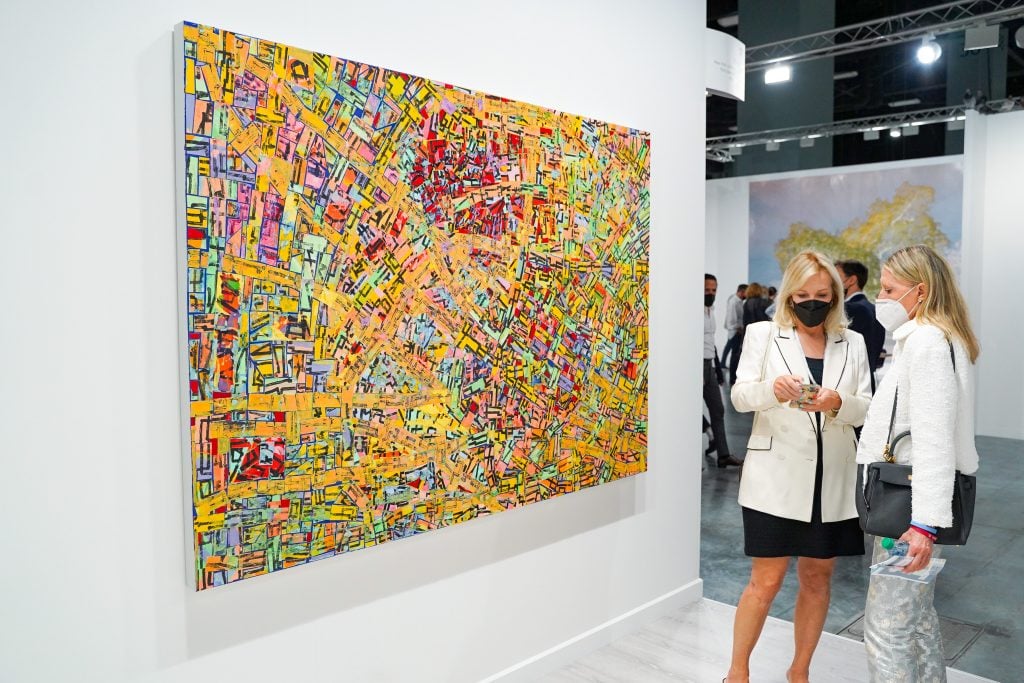
Our columnist surfaces from a research binge with insights into how the art market may respond to the latest pandemic twist.

Tim Schneider

Every Wednesday morning, Artnet News brings you The Gray Market. The column decodes important stories from the previous week—and offers unparalleled insight into the inner workings of the art industry in the process.
This week, from private commerce back to public health…
In the aftermath of Miami Art Week, the industry’s last major in-person event of the year, the conversation perennially turns to what lies in store once the calendar finally flips over. Despite a bombastic return to business (mostly) as usual in south Florida last week, the recent emergence of the Omicron variant once again makes COVID-19 the most important vector in almost any attempt to make projections about the art business in 2022.
Speculation about Omicron and its eventual impact was already a major theme in most conversations I had during my sojourn to Miami, with the subject’s prevalence ramping up the closer we all got to our departing flights. My guess is that the art trade’s obsession with the variant will only increase now that most of its members, myself included, have little else to occupy our time with except end-of-year wrap-ups.
How useful that fixation is depends on how much of it is grounded in good information. So, in an attempt to help all of us combat the rumor mongers and fake-news proponents we’ll inevitably encounter inside and outside the profession between now and New Year’s, below are the results of a classic Gray Market Research Binge ©. This time, it’s funneled into a Q&A format that aims to suss out what we know about Omicron, what we don’t, and how both should influence our next moves as 2021 morphs into 2022. Here we go…
Yes! This would have been true even if Omicron hadn’t displaced the Delta variant as the crux of COVID discourse in the past two weeks, but it’s even more important now.
I missed way more dinners, parties, and after-parties than I went to, but I still took part in enough unmasked and indoor social/networking situations over five days and four nights to warrant getting swabbed when I got back. (Negative, for the record.) So don’t act like you didn’t—and don’t be a jackass about your responsibilities to your fellow humans afterward.
If you need some extra motivation to get tested this week, keep in mind that the intrepid Annie Armstrong wrote in Friday’s Wet Paint that she was hearing “forged vaccine cards were abundant” during Miami Art Week. On top of that, the first confirmed Omicron case in the U.S. was a dude who attended—you guessed it—a culture-sector trade show last month. Specifically, the Anime NYC convention, which took place at the Javits Center from November 19 to 21. (A spokesperson for New York’s Test and Trace Corps told the New York Times, “We haven’t found evidence of widespread transmission at the convention.”)
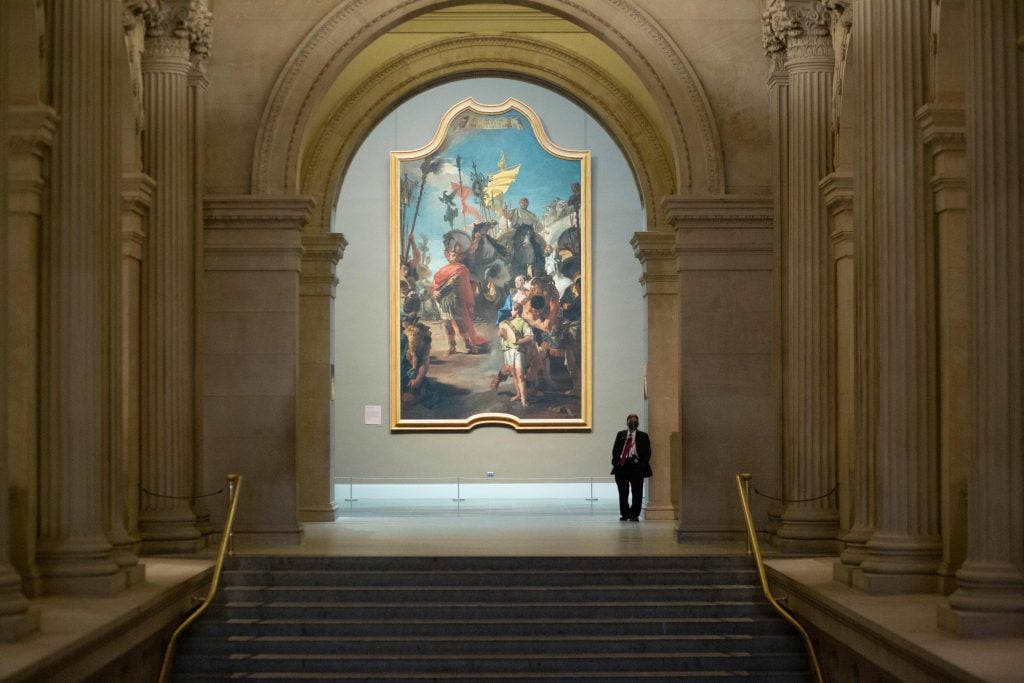
A security guard stands at his post at the uncharacteristically empty Metropolitan Museum of Art in September 2020. (Photo by KENA BETANCUR/AFP via Getty Images)
Early evidence suggests that Omicron is probably more transmissible than Delta, but that it might cause milder illness on average. I’m italicizing those qualifiers because the experts I’ve come to trust most during the pandemic say we still need more information to be confident.
On transmissibility, epidemiologist Rebecca Wurtz of the University of Minnesota told the New York Times this Tuesday that “Omicron is more contagious” than Delta based on what she’s seen. Dr. Robert Wachter of the University of California, San Francisco, said there was “not much doubt that Omicron spreads faster than Delta” but added that we’re “still not 100 percent sure why.” Is it better at jumping from unprotected person to unprotected person? Or at causing breakthrough infections among those with an acquired immune response? Or both?
We don’t know yet. This entire exercise is complicated by the fact that, for now, the global medical community can really only look to South Africa for answers. That’s not ideal beyond just typical small-sample-size concerns.
South Africa’s population skews young (meaning less likely to get very sick from COVID on average) and is largely unvaccinated. Only about 35 percent of eligible adults there have received all their jabs despite ample supply, with the main drag being vaccine skepticism—a legacy left behind by decades of shameful medical malpractice by international actors.
Data from the U.K. will start to fill out the picture soon. British officials identified 246 cases of Omicron over the weekend, and the country’s testing and virus-sequencing infrastructure is one of the world’s best (along with South Africa’s). Other nations will be able to contribute soon; Omicron has now been confirmed in at least 45 countries (and 16 American states).
Still, sociologist and New York Times Opinion columnist Zeynep Tufekci, one of our most consistently prescient sources on the pandemic’s trajectory, tweeted on December 1 that it was “absolutely too early to conclude that Omicron is milder or more severe on average, or that vaccine efficacy will be preserved as is, or not—or even why exactly it’s spreading.” Which leads to the next question…
Tufekci wrote on November 28 that we would need “about two to three weeks” for lab research and epidemiological data to begin to clarify questions about transmissibility, average severity of illness, and vaccine evasion. This column was published 10 days later, or roughly at the midpoint of her timeline. She followed up that projection on December 5 by estimating that it could take until “the end of December or even early January” to begin to settle the severity question. (Hospitalizations and deaths usually lag infection by a number of weeks.)
One crucial postscript is in order here, too: A more transmissible variant of a novel virus like COVID-19 is automatically deadlier on an epidemiological level even if it is no more harmful on an individual level, as UCLA virology researcher Dylan H. Morris wrote last May. That’s because every infection carries a risk of severe illness or death, particularly if the patient is unvaccinated, immunocompromised, elderly, or has other complicating factors. Since a more transmissible virus means more infections overall, then it will be deadlier to the population as a whole, even if it is no more likely to cause severe illness or death for the average person who catches it.
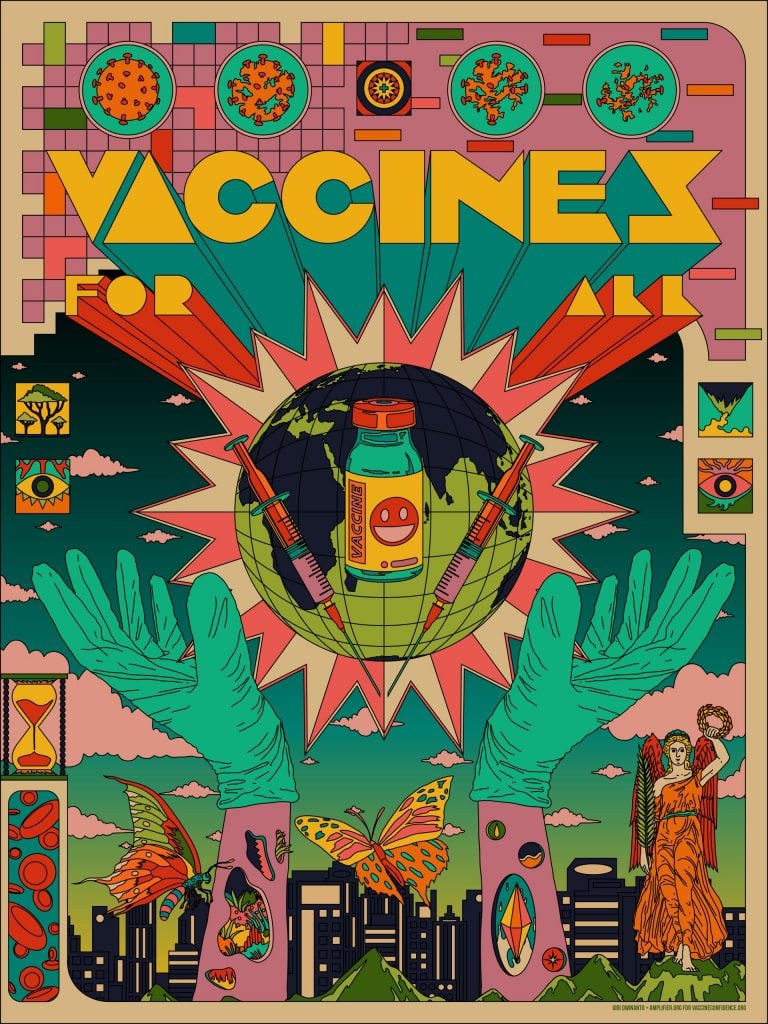
Giri Dwinanto, Vaccines For All (2021). Courtesy of the artist via Amplifier’s #vaccinated campaign.
Super, duper low, and bordering on zero for what really counts. Fortunately, viruses still basically follow the same evolutionary laws as every other life form. Morris put it this way: “Immune escape is rarely rapid and complete; it’s more often gradual. We don’t see viruses abruptly change so much that everyone with protective immunity loses all their protection and the virus regains the full severity associated with full novelty.”
So could our existing vaccines be less effective against Omicron infections? Yes. But as Tufekci wrote, they should still “maintain a good level of protection against hospitalizations and deaths,” just as they have when confronted by previous variants.
Remember, the shots are engineered to try to block all degrees of infection (from the asymptomatic to the worst-case) and to eliminate severe outcomes. Those two functions play out via different parts of the immune response. Most of the vaccines have proven to be extremely effective at preventing deadly illness, even against subsequent variants that have been harder to stave off completely. The whole of scientific history suggests this trend is still likely to hold, regardless of what we find out about Omicron’s attributes in the next month.
International investors appear to be pretty much over Omicron already. After a downturn last week widely ascribed to anxiety over another dark chapter in the pandemic, financial markets bounced back strong to open this week.
By the close of trading Monday, the S&P 500 “had recovered nearly all of its losses” since news of Omicron screamed through media outlets in late November, according to the New York Times Dealbook. U.S. exchanges saw big gains in energy, industrials, airlines, cruise-ship operators, hotels, and other positions tied to the continued reopening of the economy, as well as a sharp increase in the price of 10-year U.S. treasury bonds per analysts at CNBC.
Monday’s edition of Dealbook also noted that “European markets were flat to up, as investors appeared to grow less worried about the latest coronavirus variant.”
It’s likely these results are a sustainable trend rather than a two-day anomaly. Over the course of the pandemic, the S&P has dipped less during, and recovered faster from, every subsequent macro scare about COVID.
By no means am I suggesting that Wall Street should be your most trusted source for public-health information. Still, given how many trillions of dollars of business depend on their risk-modeling capabilities, as well as how much more perception matters than reality when it comes to economic outcomes, the resilience shown by the money men is not nothing.
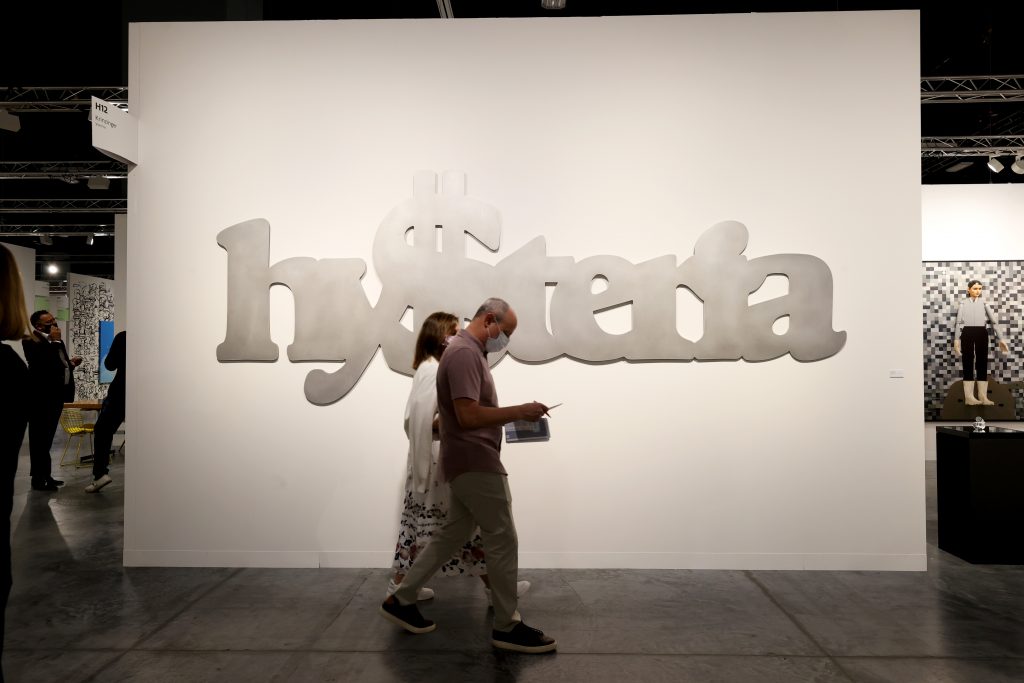
Monica Bonvinici’s Hy$teria (2019) at Art Basel Miami Beach 2021. (Photo by Cindy Ord/Getty Images)
No. Remember, one of the best indicators for art sales is the performance of investors’ stock portfolios. Assuming no other sudden shocks hit the financial markets, buyers look primed to keep spending some of their mounting wealth on paintings, sculptures, NFTs, and other art forms in the face of Omicron.
That outcome seems even more probable given that sales at Miami Art Week were robust across fairs during what now looks to have been the most pessimistic portion of Wall Street’s Omicron-response cycle. If the worst of the scare couldn’t hold back last week’s spree, my guess is that art sellers are going to be just fine.
State-imposed restrictions. Several European countries are already aggressively clamping down on residents. Austria instituted what the BBC termed a “nationwide lockdown” in mid-November, before Omicron was discovered. Germany recently “banned the unvaccinated from much of public life,” in the words of the Times, with a nationwide jab mandate looming next year.
Ireland is keeping all nightclub doors closed and limiting group meet-ups, while Italian bars can only welcome inoculated patrons. Belgium implemented a mandatory work-from-home order and started students’ Christmas vacations a week early. And then there are the absurdly designed travel restrictions imposed by the U.S., which is once again acting as if a worrisome virus variant behaves differently for travelers with passports issued by Uncle Sam.
These policies are already interrupting some parts of the global art trade. I had one planned meeting cancelled in Miami last week because an internationally based contact could no longer leave their country of residence due to renewed virus restrictions. I met with another who said they plan to keep traveling continuously for as long as possible because, if they returned home again, there was no telling how much longer outbound flights would be allowed to go wheels up amid Omicron.
These episodes cast a shadow over what otherwise felt largely like a return to form in Miami, but for the time being, they are still exceptions. The good news for the market is this: even if buyers, sellers, and artists have to cancel or delay trips they were (finally) expecting to take next year, we now have ample evidence that it won’t derail many deals.
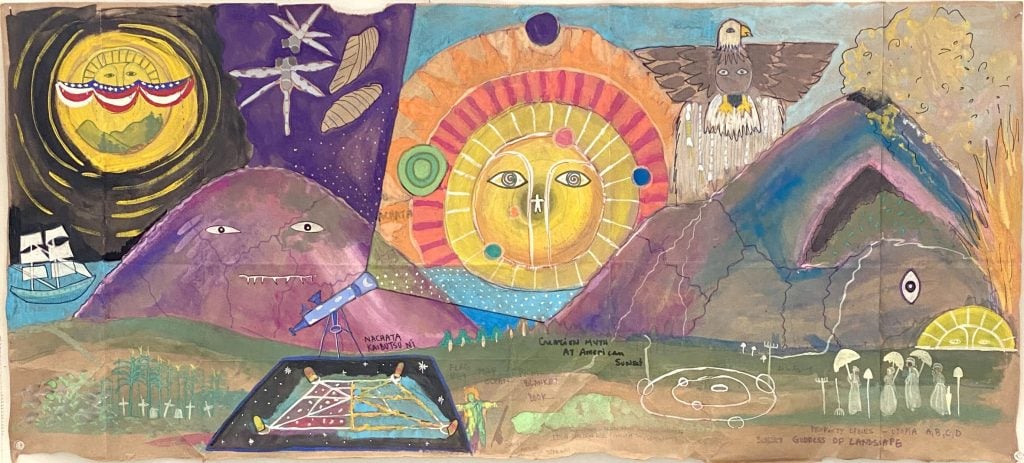
Saya Woolfalk, We Emerge from the Sunset of Your Ideology (2020). Courtesy of the Artist and Leslie Tonkonow Artworks + Projects.
I am, actually! In fact, I’ll amp up the sunshine. Even if Omicron turns out to be more transmissible than Delta, better at penetrating immune defenses, more likely to cause severe illness, or any combination of the three, that does not necessarily mean it will replace Delta as the dominant COVID variant worldwide.
Remember, a number of other “variants of concern” emerged in the past year but faded almost just as quickly. Morris’s May 2020 story referenced B.1.1.7, B.1.351, and P.1, which spiked heart rates and caused real damage in the U.K., South Africa, and Brazil in December 2020 and January 2021… and then basically disappeared.
Omicron could still follow a similarly truncated path, but it’s probably going to monopolize the conversation for the rest of December at least. How far it reaches beyond that is still anyone’s guess. Hopefully, this column was enough to make it a halfway educated one for all of us.
[The New York Times | The Insight]
That’s all for this week. ‘Til next time, remember: this mess isn’t over, but the very worst of it really, truly is.